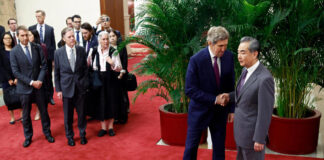APRIL 30, 2019

TOKYO — Three decades after he ascended the Chrysanthemum Throne, Emperor Akihito on Tuesday became Japan’s first monarch in more than two centuries to abdicate, passing the symbolic role to his eldest son in a brief, unadorned ceremony at the Imperial Palace.
Akihito, 85, the son of the wartime emperor Hirohito, relinquished the throne to Crown Prince Naruhito, 59, who will receive the sacred imperial regalia in a ceremony on Wednesday morning. The last emperor to abdicate was Kokaku, in 1817.
“Since ascending the throne 30 years ago, I have performed my duties as the emperor with a deep sense of trust in and respect for the people, and I consider myself most fortunate to have been able to do so,” Akihito said in a short address inside a state room at the palace, in central Tokyo.
The emperor, once regarded as a demigod, is now an entirely symbolic figure in Japan. Akihito, along with his wife, Empress Michiko, have been hugely popular among the Japanese as they have sought to bring the monarchy much closer to the people.
Akihito and Michiko traveled across Japan, and were a consoling presence particularly after disasters. They visited the Kobe region after the 1995 earthquake that killed close to 6,500 people, kneeling before survivors in a break with tradition.
After the 2011 earthquake and tsunami that killed almost 16,000 people in northern Japan and caused a nuclear disaster, the emperor gave an unprecedented nationally televised address, asking people to act with compassion “to overcome these difficult times.”
In a farewell address to the departing emperor, Prime Minister Shinzo Abe noted that Japan had faced numerous challenges during Akihito’s reign.
“In such cases, His Majesty the Emperor, together with Her Majesty the Empress, have stood close to the people, and encouraged the victims of disasters,” he said. “He gave people courage and hope for the future.”

As the successor to Hirohito, Akihito also took on the mantle of atoning for Japan’s wartime sins. He traveled widely throughout Asia to countries that had been attacked or conquered by Japan during World War II, and spread a message of pacifism.
When Akihito took over the throne in 1989, it was after his father had suffered a prolonged illness. Akihito, who was treated for prostate cancer in 2003 and underwent heart surgery in 2012, may have wished to avoid subjecting his son to a period of such limbo.
But the decision to abdicate was not the emperor’s alone to make, and he ultimately had to wait three years after first expressing his desire to step down. The abdication required a special act of Parliament, passed in 2017. The law applies only to him and not to future emperors.
During the ceremony on Tuesday, which lasted just over 10 minutes, the emperor and empress stood solemnly on a stage in a state room with wood flooring that evoked a high school gymnasium.
A crowd of nearly 300 politicians, Supreme Court judges and their spouses sat watching the proceedings, in which palace chamberlains placed an imperial sword, jewels and seals, all wrapped in silk cloth, on Japanese cypress benches flanking the stage.
Akihito wore a topcoat and tails with a silver tie, and Michiko wore a floor-length silver-white gown with white gloves.
In his brief address, Akihito did not directly refer to the fact that he was abdicating. With Crown Prince Naruhito and his wife, Masako, standing to the side just off the stage, the departing emperor said he had prayed that the new era would be “peaceful and fruitful.”
At the end of the ceremony, Akihito, now emperor emeritus, stepped down from the stage, turned and waited. He wanted to give his wife a hand down the steps.
Outside the palace, a crowd of about 1,000 people gathered to commemorate the abdication and perhaps catch a glimpse of the retiring emperor. Security was tight as dozens of police officers patrolled the grounds.
Mieko Tomiyama, 65, a nurse visiting from Tochigi, north of Tokyo, to see the musical “Les Miserables,” wore a purple kimono as she stopped by the palace.
“The emperor and Michiko and other royals seem to be people who are from another world,” Ms. Tomiyama said. “But they tried to be close to commoners.” She added that she hoped that the new emperor and empress would “remain as symbols of peace in Japan and that no conflicts or wars will occur.”
With Akihito’s abdication, he becomes known as the Heisei emperor, after the name given to the era in which he reigned. Imperial custom dictates that the reign of each emperor is accompanied by a name for his term in power. The new era, known as Reiwa, begins on Wednesday.
Anticipating Crown Prince Naruhito’s ascension, some visitors to the palace grounds on Tuesday said they hoped that his wife, Masako, could help nudge Japan closer to gender equality. Before marrying Naruhito, the princess was a diplomat in the country’s Foreign Ministry.
“I hope she will be active in international relations as the empress,” said Misa Minoura, 23, an office worker from Chiba, southeast of Tokyo. “I hope the society will be better so that women can participate more.”

































































































